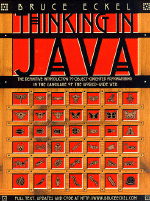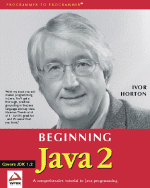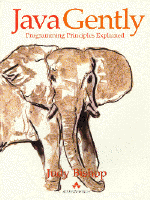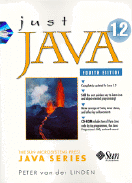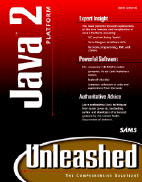New to Java? We'll help you get started with our revised beginner's tutorial, or our free online textbook.
|
|
 Get the latest Java books |
|
|
h t t p : / /w w w . j a v a c o f f e e b r e a k . c
o m /
|
||
|
Menu Articles Using Java Applets Looking for Java resources? Check out the Java Coffee Break directory! |
Java Coffee Break
|
||||||||||
Thinking in Java,
Thinking in Java is a comprehensive guide to the Java programming
language, written by the Bruce Eckel (author of the hugely successful Thinking
in C++ series). This is an amazing book, not only for its content
but also its distribution. Bruce Eckel gives the entire text of his book
in Adobe PDF format away from his website, without charging. The
'electronic' edition of this book is a companion to the print edition,
which retails for a modest price considering the size of the book and
the value of the content within.
|
Thinking in Java, Experience level : |
Beginning Java 2,
|
Beginning Java 2, Experience level : |
Java Gently, by Judy BishopThis review relates to the first edition Java Gently teaches the principles of computer programming, and the Java language, rather than just teaching Java in isolation. Unlike other books, it requires no previous programming experience, because it teaches fundamental concepts alongside Java. It has a good emphasis on object orientated design; class diagrams are used extensively throughout the book to make it easy to understand how examples work. Working through the book will teach you how to program - not just how to write simple applets. This isn't a quick guide to Java, so not everyone will appreciate this approach. Examples in the book teach a wide range of topics, from simple concepts like conditional branching and looping, to high level concepts like exception handling, abstraction, data structures and networking. The approach taken by the book introduces topics gradually, and makes it easy to pick up the skills needed to program in Java. Other books attempt to teach a narrow range of topics, such as Java applets or user interfaces within a very short time-frame, whereas this book has a more broad scope that will make future programming easier. If Java is your first programming language, and you're considering it as a career, you should make this one of your first books.--David Reilly. |
Java Gently, Experience level : |
Just Java 1.2, by Peter van der LindenReview Courtesy of Amazon.com Shying away from complicated aspects of the language that are seldom used in most practical situations, Peter van der Linden focuses his considerable teaching skills upon the parts of the language you really need to understand in order to be a good Java programmer. He covers basic structure and syntax very well, and gives similarly excellent attention to object orientation and the means by which Java implements it. Applets, Beans, input/output streams, basic graphics, Swing, and security all get superb coverage. In short, this book explains everything you really need to know in order to write useful Java programs. With sharp text and very good example programs, the author shows you how to get things done. In the process, van der Linden--a funny guy--pauses often to show you how to make an origami water-bomber or comment upon software error messages like "runt packet." The CD-ROM that comes with this book deserves much praise, as well. Packed with honestly useful tools and all of the author's examples, it employs a fine HTML-based interface that other books ought to imitate. --David Wall. |
Just Java 1.2, Experience level : |
Java 2 Platform Unleashed, by Jamie JaworskiI've always been a big fan of the Java Unleashed series of books, not only for their ability to teach the Java programming language, but also for their comprehensive coverage of the Java language, its API, and advanced topics like multi-threading, networking, and Java extensions. This type of coverage means that they can be used afterwards as a programming reference. With the release of the Java 2 platform, however, there have been many changes including Swing, servlets, CORBA, and increased multimedia support (Java Media Framework, Java 2D, Java 3D). Some books might have adopted a superficial approach, covering only the most obvious of changes, and leaving out the new Java extensions. So it's with great surprise, and a little relief, that "Java 2 Unleashed" continues the fine tradition of its predecessors, by providing comprehensive coverage of all the new changes and features of Java 2. While many references give only superficial coverage of topics, "Java 2 Unleashed" takes a detailed look at the Java 2 Platform. Whether you're interested in upgrading your applications to use the rich range of new Swing components, want to create interactive applets to spice up a website, or even write client/server networking applications, this book covers it! But it goes further still. There are chapters on using the system clipboard, implementing drag and drop support, printing, and internationalization. Its coverage on networking and distributed systems covers remote method invocation (RMI), content handlers, JavaMail, CORBA and network programming (total of seven networking chapters). For those interested in Java's multimedia support, there are chapters covering the new Java 2D & Java 3D APIs, implementing animation in applets, and the new Java Media Framework (JMF). Even more impressive is the comprehensive look at developing and using JavaBeans (six chapters in total). This is the ultimate reference, and makes it easy to get a handle on the new changes in the Java 2 Platform. Nor is this title limited only to the new innovations which would interest existing Java developers. This book takes on the awesome challenge of introducing someone new to Java to the Java 2 platform, taking it slowly from applets to applications, through AWT & Swing, as well as the core Java packages (java.lang, java.util, java.net), database programming with JDBC, development tools, and all the practical information gathered from the author's experience. "Java 2 Platform Unleashed" is a fine addition to the library of any programmer, be they experienced in Java or still learning it.--David Reilly. |
Java 2 Platform Unleashed Experience level : |
Reference Books
There are plenty of good reference guides for Java. Here are our favorite recommendations
- Java in a Nutshell, 3rd Edition - covers all the core API except for Swing/AWT, updated for Java 2 v 1.3
- Java in a Nutshell, 2nd Edition - covers all the core API, including Swing/AWT, updated for Java 1.1
Graphical user interfaces
GUI programming is an important part of most applications and applets. Here are some guides to get you started
- Java 2 in Record Time - covers basic Java for beginners, with a very heavy emphasis on GUI programming
- Java Swing - covers the entire Swing library, in great detail
- The JFC Tutorial - Sun Microsystem's guide to Swing
- Pure JFC Swing - covers the Swing API and JFC
Networking & Distributed Computing
- Java Network Programming 2nd Edition
- Client Server Java Programming with Java & Corba
- Developing Java Servlets
- Distributed Programming with Java
- Inside Servlets
- JavaSpaces, Principles & Practice
- Professional Java Server Programming
- Professional Java Server Programming J2EE Edition
- Professional JSP
- The Jini Specification
- Web Development with JavaServer Pages
Special Topics
- Database Programming with JDBC and Java
- Intelligent Java Applications
- Internet Game Programming with Java
- Java 2 Certification Guide
- Java 2 Platform Unleashed
- Java Pitfalls
- JBuilder 3 Unleashed
- Developing JavaBeans Using VisualAge for Java, Version 2
- Taming Java Threads
- Teach Yourself Java 2
- Professional Java XML
|
Copyright 1998, 1999, 2000 David Reilly
|
Privacy | Legal | Linking | Advertise! |
|
Last updated:
Monday, June 05, 2006
|


